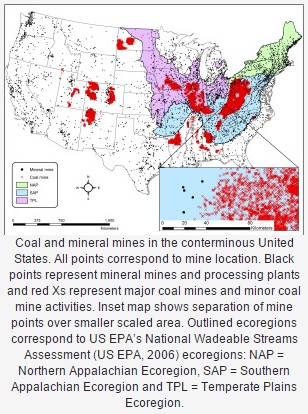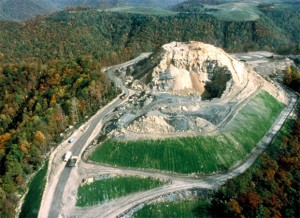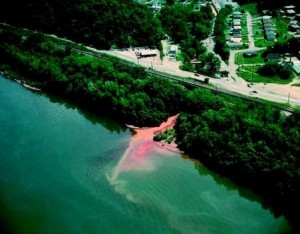A unique study of landscape factors–in particular, mines–as regional sources of stress has been conducted by Michigan State University researchers. The study involved waterways in 33 U.S. states and 22,000 fish community samples. The researchers were themselves surprised by the results: even a single mine can damage fish habitats in larger rivers downstream, and the effects can reach streams not even directly connected to a mine.
“Mines have a much stronger influence on fishes than has been assumed,” Dr. Wesley Daniel, a research associate at MSU and lead author of the study, said. “It’s important, when considering the location of a new mine, to not just look local–but look way downstream.”
Here Dr Daniel explains the research, which has relevance in every part of the world where mining occurs.

Our study was funded by the US Fish and Wildlife and US Geological Survey as part of efforts to characterize associations between landscape factors, including coal and mineral mines, on stream fish communities in a range of stream sizes in the eastern US.
We wanted to test whether mines operate as a regional source of stress to fish communities over large spatial extents, as has been shown in many previous works examining urban and agricultural land use.
One of the striking results was the clear and consistent negative associations between fish and mines across all three regions, and that these relationships held true for many different groupings of fishes. Examples of groupings include game species (fish species targeted by anglers like trout, bass, catfish), intolerant species that cannot endure much disturbance, fishes that use various habitats for spawning or their life cycle, and tolerant species that are often found to increase in disturbed areas.  We found that tolerant species decreased in abundance with increased mine density in the watershed.
We found that tolerant species decreased in abundance with increased mine density in the watershed.
We found that a single mine in a small river’s watershed (1000 km2 watershed) has the potential to alter the fish community by decreasing the number or diversity of fishes. When considering the effect of mines (current or new), managers need to consider not only the local stream watershed but the downstream impact.
There is an opportunity for management and agencies to use the our results along with the advancements in GIS mapping data we have created to consider mine’s influence as a regional source of stress and improve fisheries through management actions. Mining will continue to be needed until an adequate substitution can be found. As a society, we should be thoughtful on where mines at placed, keeping them out of ecologically or culturally significant watersheds. Since, based on our results, a very low density of mines has the potential to alter the fish community in large areas.
We found strong associations between greater numbers of mines in watersheds and lower numbers and diversity of fishes. We tested both  mineral and coal mines together and separately and saw associations with altered fish communities. We did not test specifically for mechanisms by which mines could affect stream fishes, but many other studies that have been conducted at smaller spatial scales have demonstrated specifically how mines can affect stream fishes (mines can be a source of sediments and chemicals into rivers, alter the flow of streams, and alter natural land covers all of which can change stream habitats). What makes our study unique is that it was conducted over a large spatial extent, and we repeated our analyses in each of three regions that cover all or portions of 33 states in the central and eastern US. Also, our associations were based on trends
mineral and coal mines together and separately and saw associations with altered fish communities. We did not test specifically for mechanisms by which mines could affect stream fishes, but many other studies that have been conducted at smaller spatial scales have demonstrated specifically how mines can affect stream fishes (mines can be a source of sediments and chemicals into rivers, alter the flow of streams, and alter natural land covers all of which can change stream habitats). What makes our study unique is that it was conducted over a large spatial extent, and we repeated our analyses in each of three regions that cover all or portions of 33 states in the central and eastern US. Also, our associations were based on trends  detected using 22,000 fish community samples.
detected using 22,000 fish community samples.
Our results suggest that a single mine has potential to alter fish communities. We cannot provide a unique value for the distance the mines can influence fish communities. The distance downstream that mining can influence fish communities will vary based on stream size, number of mines, and regional variation in natural conditions. There is an opportunity for future studies to build upon our results and try to quantify and characterize distance downstream in various regions that mines influence aquatic communities.
The report, “Characterizing coal and mineral mines as a regional source of stress to stream fish assemblages,” was completed by Drs. Wesley Daniel, MSU associate professor of fisheries and wildlife Dana Infante, Robert Hughes at Amnis Opes Institute, Yin-Phan Tsang, Daniel Wieferich, Kyle Herreman, Arthur Cooper and William Taylor at MSU, Peter Esselman at the U.S. Geological Survey Great Lakes Science Center in Ann Arbor, Mich., and Lizhu Wang of the International Joint Commission Great Lakes Regional Office in Detroit,” was published in the journal Ecological Indicators, and was funded the US Fish and Wildlife and US Geological Survey.

I really enjoyed this article; it was very well written and easily understood by laypeople like myself. I hope to see more articles such as this in the future…thanks!!